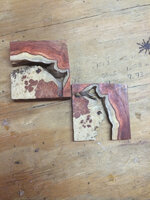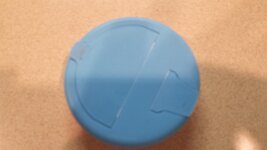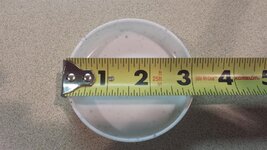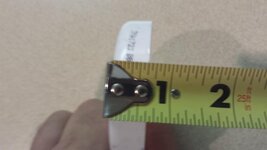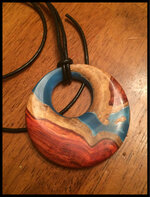Hi Dan,
A very pretty pendant you've made mate, the colour goes well with the wood colours.
There is also, a little details that I would like to share with you, do you see those light coloured edges on the resin and wood joint...??? You may not know but, there is "separation" in there, the resin is not stuck to the wood...!
There are some other causes that can make that happen in certain woods, vibrations are one culprit but, specifically with oily woods such as the wood you used, unless the natural oils are dealt with, you get the edge separation and in many cases, full separation altogether, as the resin did not adhere to the wood, as you may think...!
There are 2 "cures" for this, the best one is to neutralise the surface natural oils of the wood, I mean "surface", as most cases the wood will still maintain some oil at its centre, particularly with thicker wood than the ones you have cast, with those, the oils will be gone by, roasting the wood in an oven @ 70° celsius for a few hours. If the heat elements are expose and you want to make sure the wood wouldn't burt, wrap the wood in foil paper and use 80° celsius to make sure the oils are crystallized and therefore become a solid part of the wood, that way, the resin will adhere to the wood surface as good as any other non oily woods...!
The second option is to use the super thin CA to soak each joint of the resin/wood piece. You do this before you start working on it and if required, halfway to the finish product. In this case, and with the wood surface having some oil preventing the resin to stick well, there will be a small gap in between to 2 material, you want see it but, you will see the thin CA going in and darken the light colour resin on the edges, making the colour look even all the way through.
The thin CA is able to create a bond in between the 2 materials, CA chemical components do neutralise the wood oils in small quantities/amounts, an oily wood can maintain most of its natural oils inside, the important thing is to neutralise the surface oils if you want to have it to adhere with something else...!
The "roasting" of the oily woods, is one of the reasons why, I have successfully cast and stabilized many blanks that others have had so many troubles with, it may take a little more time in preparation but the results are well worth it...!
Cheers
George

